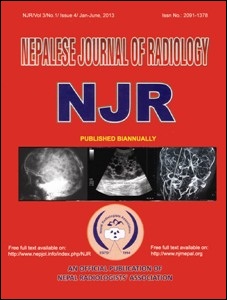Combined CT Pulmonary Angiography & Indirect CT Venography in Evaluation of Clinically Suspected Cases of Pulmonary Embolism- Our Experience in an Oncologic Setup
DOI:
https://doi.org/10.3126/njr.v3i1.8795Keywords:
CT Pulmonary angiography, CT venography, Deep vein thrombosis, pulmonary embolism, pulmonary scintigraphyAbstract
The study was aimed at evaluating role of CT Pulmonary Angiography (CTPA) and Indirect CT venography (ICTV) in clinically suspected pulmonary embolism (PE) in oncology setup.17/31 (54.9%) patients were diagnosed with PE with or without deep vein thrombosis. DVT was diagnosed in 12(38.7%). 1 patient had DVT in absence of PE while 13/31 (41.9%) patients were diagnosed not to have PE or DVT. Clinical symptoms or pre-test probability determined by Well’s criteria and other laboratory investigations were not found predictive of PE. CTPA diagnosed PE with greater ease, shorter time required with no dependence on clinical pretest probability unlike pulmonary scintigraphy. In cases with CTPA negative for PE, CT described additional findings possibly explaining patient’s presenting symptoms unlike negative pulmonary scintigraphy. In cases where PE was excluded, CTV identified DVT (if present) in the same sitting, obviating separate venous Doppler. A single investigation with ability to deal with complete spectrum of DVT and PE makes CTPA & ICTV ‘one stop shop’ imaging modality for PE and DVT.
Nepalese Journal of Radiology / Vol.3 / No.1 / Issue 4 / Jan-June, 2013 / 40-52
Downloads
Downloads
Published
How to Cite
Issue
Section
License
This license enables reusers to distribute, remix, adapt, and build upon the material in any medium or format, so long as attribution is given to the creator. The license allows for commercial use.




